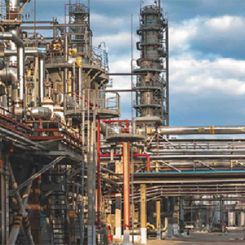The demand for the duties that fall within the performance range of reciprocating pumps is rising. Process flows are falling while the pressures required are increasing.
Engineers are generally familiar with operating principles, performance curves and selection criteria for centrifugal pumps, but the training and knowledge around the operating principles of reciprocating pumps is not as common.
Unlike centrifugal pumps, reciprocating pumps have a stronger interaction with the system within which they sit. This is due to the pressure pulsations they generate.
If we think about any linear reciprocating motion of a piston, at some point the velocity of the piston is zero as it changes direction at the top and bottom of its stroke. This means that the pressure pulsations are much larger in a reciprocating machine than in a centrifugal machine.
Centrifugal pump engineers are familiar with selecting pumps from a performance range using performance curves that map the operating range. A reciprocating pump’s flow is determined by the volume of its cylinders and the rate at which the piston can move fluid through into the system. The pump is a fixed volume machine.
 Image 1. A reciprocating pump’s fixed volume. Flow is determined by stroke, area and speed. (Images courtesy of Hydro)
Image 1. A reciprocating pump’s fixed volume. Flow is determined by stroke, area and speed. (Images courtesy of Hydro)If you want to change the flow of a reciprocating pump, the easiest way to do this is to change the rate at which the pistons move the liquid through the pumps valves into the system. As reciprocating pumps are fixed volume machines, they do not have a performance curve in the way a centrifugal pump does (Image 1). Closing the discharge valve increases the pressure but does not change the flow.
Reciprocating pumps run at a much lower speed than centrifugal pumps. By increasing the speed, there can be compromises to the packing and sealing life of the machine. Balancing speed and plunger size is the key to reliability plunger and sealing life.
Reciprocating pumps can be more efficient than centrifugal pumps, if they are used in the correct application. Reciprocating machines are generally applied on low-flow and high-head service.
Centrifugal pumps can have efficiencies as low as 20 percent on low-flow and high-head service. A reciprocating machine, on the other hand, can have efficiencies more than 90 percent on the same service.
Many users of reciprocating pumps are considering replacing their machines with diaphragm pumps due to environmental emission regulations. While reciprocating machines have a packing system that leaks, it is possible to both mitigate and collect this leakage, thus allowing the pump to meet environmental regulations. Modifying stuffing box arrangements is less expensive than replacing the machine.
Another significant difference between the performance of centrifugal pumps and reciprocating pumps is how net positive suction head required (NPSHR) is determined.
With a centrifugal pump, the NPSHR is determined when the head has dropped 3 percent under reducing suction pressure.
 Image 2. The NPSHr of a reciprocating pump based on 3 percent capacity reduction
Image 2. The NPSHr of a reciprocating pump based on 3 percent capacity reductionFor a reciprocating pump, 3 percent capacity drop is the criteria for defining NPSHR (Image 2). Net positive suction head available (NPSHa) is reduced until the capacity drop has exceeded 3 percent. The NPSH that was available at the 3 percent reduction is established, by definition, as the NPSHR.
There are a number of components within the machine that can be modified to improve NPSHR. This can be a simpler modification than that required by a centrifugal machine, where impeller design is the most common option for improving the machine’s NPSHR.
It is becoming more important for engineers to understand the performance of reciprocating pumps. There is a temptation to apply the knowledge acquired on centrifugal machines to that of the reciprocating world of pumps. This can lead to real difficulties and reliability problems.

